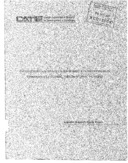| dc.contributor | Centro Agronómico Tropical de Investigación y Enseñanza (CATIE) | |
| dc.contributor.advisor | Solís, Hernán | |
| dc.contributor.author | Rivera Torres, Lisandro H. | |
| dc.coverage.spatial | Turrialba, Costa Rica | |
| dc.date.accessioned | 2014-10-20T05:02:29Z | |
| dc.date.available | 2014-10-20T05:02:29Z | |
| dc.date.issued | 2002 | es_ES |
| dc.identifier | 365018 | es_ES |
| dc.identifier.uri | https://repositorio.catie.ac.cr/handle/11554/5110 | |
| dc.description | Tesis (Mag. Sc.) -- CATIE, Turrialba (Costa Rica), 2002 | es_ES |
| dc.description | 26 ilustraciones. 42 tablas | |
| dc.description | 44 referencias en las páginas 109-114 | |
| dc.description.abstract | Los objetivos específicos fueron: la determinación de los caudales picos para diferentes períodos de retorno usando un modelo hidrológico; la determinación de áreas susceptibles a inundación y características hidráulicas del Río La Soledad usando modelo hidráulico y Sistemas de Información Geográfica (SIG); la evaluación de la vulnerabilidad y las áreas susceptibles a inundación y la propuesta de estrategias participativas para reducir la vulnerabilidad de las áreas en peligro. Para conocer la problemática de las comunidades se realizaron talleres participativos coordinados por el Proyecto de Mitigación de Desastres Naturales (PMDN-CATIE). Se logró identificar sitios críticos, así como la preparación y organización de un Comité de Emergencia Municipal (CODEM). La modelación hidrológica requirió: recolección de datos hidrometeorológicos, de uso de la tierra, suelos y geomorfología de la cuenca. | es_ES |
| dc.description.abstract | The specific objectives were: The determination of the peak discharges for different return periods using a hydrologic model; the determination of the flood prone areas and hydraulic characteristics of the Río La Soledad using hydraulic model and GIS; the evaluation of the vulnerability of the flood prone areas and the proposal of participative strategies to reduce the vulnerability of the endangered areas. In order to study the probleMON of the communities participative workshops, coordinated by the Natural Disaster Mitigation Project (PMDN-CATIE). It was managed to identify critical sites, as well as the preparation and organization of a Municipal Emergency of Committee (CODEM). Modeling of the watershed required: hydrometeorological, land use, soil and geomorphology data collection. | |
| dc.format.extent | 176 páginas | |
| dc.language.iso | es | es_ES |
| dc.publisher | Centro Agronómico Tropical de Investigación y Enseñanza (CATIE) | es_ES |
| dc.rights | CC-BY-4.0 | |
| dc.subject | WATERSHEDS | |
| dc.subject | FLOODING | |
| dc.subject | DISASTERS | |
| dc.subject | WATERSHED MANAGEMENT | |
| dc.subject | RISK | |
| dc.subject | SIMULATION MODELS | |
| dc.subject | EVALUATION | |
| dc.subject | GEOGRAPHICAL INFORMATION SYSTEMS | |
| dc.subject | SOCIAL PARTICIPATIONCUENCAS HIDROGRAFICAS | |
| dc.subject | INUNDACION | |
| dc.subject | DESASTRES | |
| dc.subject | ORDENACION DE CUENCAS | |
| dc.subject | RIESGO | |
| dc.subject | MODELOS DE SIMULACION | |
| dc.subject | EVALUACION | |
| dc.subject | SISTEMAS DE INFORMACION | |
| dc.subject | GEOGRAFICA | |
| dc.subject | PARTICIPACION SOCIAL | |
| dc.subject | HONDURAS | |
| dc.title | Evaluación de la amenaza y vulnerabilidad a inundaciones en la microcuenca La Soledad, Valle de Angeles, Honduras | es_ES |
| dc.title.alternative | Evaluation of the flood prone areas and vulnerability in the Microbasin La Soledad, Valle de Angeles, Honduras | es_ES |
| dc.type | Tesis | es_ES |
| dcterms.rights | acceso abierto | es_Es |
| dc.identifier.publication | Turrialba, Costa Rica | es_ES |
| dc.status | info:eu-repo/semantics/openAccess | |


